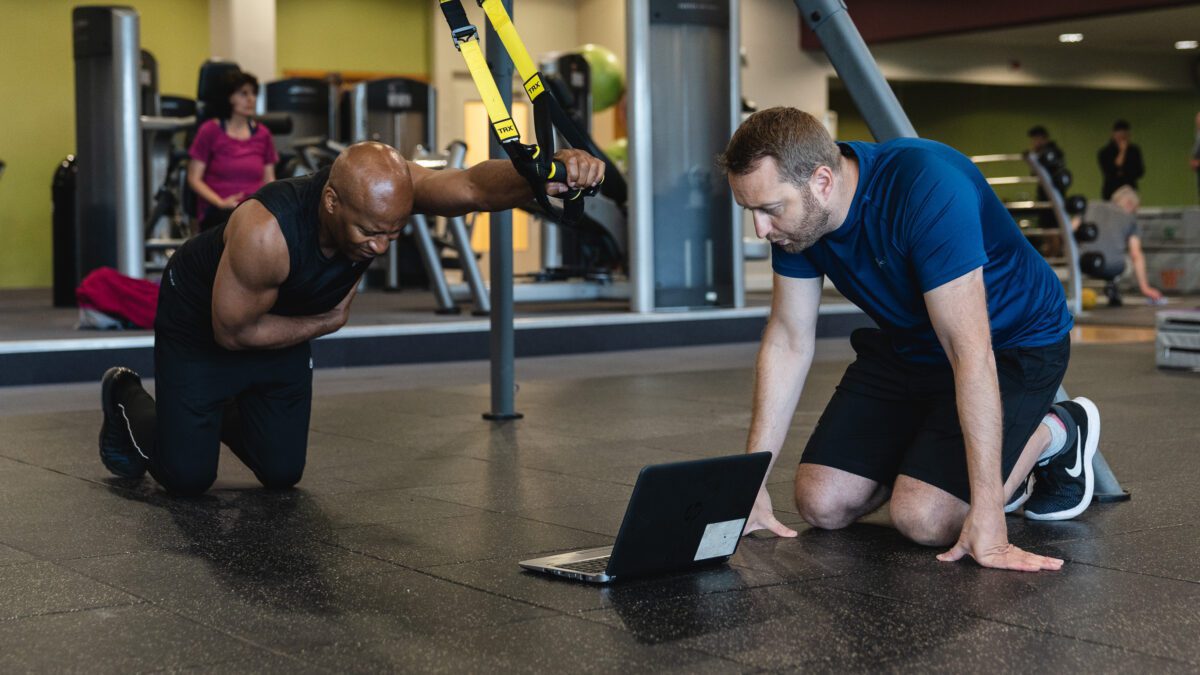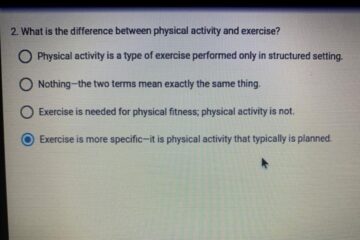A fitness instructor leads group classes, while a personal trainer provides individualized workout guidance. Fitness instructors focus on leading sessions, personal trainers customize fitness plans.
The difference between a fitness instructor and a personal trainer can dramatically enhance your workout experience and enable you to reach your health goals. A fitness instructor typically operates group classes, aiming to energize and motivate attendees through a predefined set of exercises.
This role is ideal for those who enjoy the community aspect of fitness and are looking for structured, routine workouts. On the other hand, personal trainers delve into one-on-one interactions, tailoring fitness programs to an individual’s unique needs and abilities. They’re not just instructors; they’re coaches, mentors, and sometimes therapists, supporting you through every step of your fitness journey. The choice between a fitness instructor and a personal trainer depends on your preferences for personal attention, the motivation you require, and the specificity of your fitness objectives. Choosing the right professional can be the key to not only meeting your fitness targets but also maintaining an enjoyable and sustainable exercise habit.
Decoding The Roles: Fitness Instructor Vs. Personal Trainer
Stepping into a gym, you may spot various fitness professionals. Two key roles might catch your eye: fitness instructors and personal trainers. The focus, function, and approach of the two organizations differ, despite the fact that they share the same goals. Let’s decode their distinct roles.
Core Responsibilities Of A Fitness Instructor
Fitness instructors are the backbone of group exercise sessions. They guide and energize classes, ensuring everyone stays safe and motivated. Their core responsibilities include:
- Creating Workout Plans: Crafting sessions that cater to all fitness levels.
- Leading Group Sessions: Demonstrating exercises and maintaining an upbeat tempo.
- Ensuring Safety: Watching form and technique to prevent injuries.
- Setting Up Equipment: Preparing the space with necessary tools for a smooth class.
- Offering Modifications: Adjusting moves to accommodate varying abilities.
The Unique Profile Of A Personal Trainer
The one-on-one approach of personal trainers makes them stand out. Personalized fitness regimens are designed to meet the goals of each individual client. Several things make personal trainers stand out:
- Assess Individual Needs: Tailoring exercise and diet plans for optimal results.
- Monitor Progress: Tracking improvements and tweaking plans accordingly.
- Offer Motivation: Providing encouragement and accountability to clients.
- Teach Proper Techniques: Ensuring exercises are done correctly to maximize benefits and reduce injury risks.
- Adapt to Challenges: Modifying routines to keep up with changes in a client’s health or fitness level.
In summary, while both roles serve to inspire and facilitate fitness journeys, their methods and audiences differ. Fitness instructors rally the group, while personal trainers zoom in on the individual’s goals.

Credit: www.youtube.com
Educational Pathways And Certifications
Getting the right education and certification is the first step to starting a fitness career. Fitness instructors and personal trainers follow different paths. Each requires a specific level of training and credentials. Let’s look at what distinguishes the two professions in terms of education and certification.
Training Required For Fitness Instructors
Fitness instructors lead group classes. They need a clear understanding of exercise forms. Often, they specialize in areas like yoga, pilates, or aerobics. The table below outlines the essential training.
| Training Type | Description | Duration |
|---|---|---|
| Group Exercise Certification | Basics of leading group workouts | 3-6 months |
| Specialty Classes | Training in specific class types | Varies |
Certification Processes For Personal Trainers
One-on-one training is provided by personal trainers. They create customized workout plans. They must understand anatomy and nutrition deeply. Below is their certification process in bullet points.
- High school diploma or equivalent required
- Complete a certified personal training course
- Pass a certification exam
- Maintain certification with continuing education
Client Interactions And Typical Settings
Understanding the roles of fitness instructors and personal trainers begins with their client interactions and typical settings. Each profession tailors its approach to fit the unique needs and goals of their clients. This distinction is especially clear when comparing group dynamics in classes and one-on-one personalized sessions.
Fitness Instructor: Group Dynamics And Gym Classes
Fitness instructors thrive in group settings. They lead classes where participants follow a common routine. These settings often include:
- Gyms and fitness centers
- Community recreation facilities
- Outdoor public spaces
Their focus lies in engaging all participants, creating a supportive atmosphere characterized by:
- Energy and motivation
- Synchronized movements
- Music to boost excitement
Instructors ensure classes are accessible and enjoyable, catering to various skill levels within the group.
Personal Trainer: One-on-one Focus And Customized Plans
Personal trainers focus solely on individual clients. Their services are often utilized in:
- Private training studios
- Client’s homes
- Specialized gym sections
A personal trainer develops a detailed and customized plan, unique to each client’s goals. This plan includes:
- Targeted exercises
- Nutrition and lifestyle guidance
- Progress tracking
- Adaptability to client’s changing needs
This personal approach helps clients see results quickly and efficiently.

Credit: www.stormfitnessacademy.co.uk
Skill Sets And Expertise Areas
Understanding the different roles in fitness can help you choose your career path. When it comes to skill sets and expertise areas, fitness instructors and personal trainers each have their unique strengths. Let’s explore what sets them apart in more detail.
Skillset Diversity Of Fitness Instructors
Fitness instructors are known for their broad range of abilities. They lead classes and help groups to achieve fitness goals. Here, we’ll talk about the variety in the skills that fitness instructors bring to the gym floor.
- Group Engagement: They excel in creating a dynamic environment for multiple participants.
- Varied Routines: Instructors must design workouts that suit a wide range of fitness levels.
- Music and Choreography: These pros often integrate music and dance into routines.
- Injury Prevention: They prioritize safe exercises to prevent group injury.
- Motivational Skills: Keeping a class motivated is key for workout success.
Specialized Knowledge Of Personal Trainers
Personal trainers dive deeper into the individual needs of their clients. Their specialized knowledge is critical in sculpting personalized programs. Let’s see what expertise personal trainers must master.
- Anatomy and Physiology: They have deep understanding of the body’s functions.
- Nutritional Guidance: Trainers provide clients with diet plans to complement their workout.
- Personalized Program Design: They tailor workouts to each individual’s goals and abilities.
- Progress Monitoring: Detailed tracking of client progress is essential.
- Rehabilitative Exercise: They often help with exercises post-injury.
Impact On Client Goals And Outcomes
The success of fitness journeys immensely depends on the guidance received. Individuals have diverse needs, leading to different impacts on their goals and outcomes. Understanding the distinction between fitness instructors and personal trainers clarifies what one can expect from their fitness experience.
Instructor-led Fitness Transformations
Group settings often feature instructor-led classes. Here, a fitness instructor designs workouts for everyone. A key outcome of such sessions is how participants discover motivation in a communal atmosphere.
- Camaraderie fosters consistency.
- Structured classes simplify the fitness routine.
- One gains from an energy-filled environment.
These collective experiences can lead to significant fitness transformations, as participants push each other towards common goals.
Achieving Personal Milestones With A Trainer
Personal trainers tailor the experience to an individual’s goals. They assess personal abilities and limitations to create a customized strategy.
- Focused one-on-one sessions help in achieving specific goals.
- Constant feedback refines the approach.
- Customized routines break plateaus.
Personal trainers play a pivotal role in steering clients towards their personal milestones. This personalized guidance often translates into measurable achievements.
| Feature | Fitness Instructor | Personal Trainer |
|---|---|---|
| Setting | Group | Individual |
| Focus | General Fitness | Personal Goals |
| Outcome | Group Success | Personal Milestones |

Credit: origympersonaltrainercourses.co.uk
Financial And Career Considerations
Choosing between a fitness instructor or personal trainer role involves understanding the differences in earnings and career growth. Each role offers distinct financial benefits. They also come with unique opportunities for advancement. Let’s explore the monetary aspects and career potential for both paths.
Earning Potential And Opportunities For Instructors
Fitness instructors lead group classes in gyms or studios. They often get paid per class or hour. Some work part-time. Others make it a full-time career. The pay can vary based on:
- Location: Cities often pay more than rural areas.
- Experience: Instructors with more skills usually earn higher wages.
- Type of class: Specialized classes like spinning could offer more money.
Earnings can increase by getting additional certifications. Instructors might also move into management. This can lead to higher pay. Some even create their own fitness brand or videos, expanding their income sources.
Building A Business As A Personal Trainer
Personal trainers work one-on-one with clients. They often charge per session. Rates can be high, especially with special skills or experience. Successful personal trainers may:
- Build a client base: More clients mean more steady income.
- Specialize: Trainers with niches often charge more for their services.
- Expand services: Offering online coaching or writing fitness plans boosts earnings.
Many personal trainers start their own business. This requires marketing skills and a good network but can be very rewarding. Some trainers branch into product sales or opening their own gym as well.
Frequently Asked Questions Of What Is The Difference Between Fitness Instructor And Personal Trainer
Is Fitness Instructor The Same As Personal Trainer?
A fitness instructor typically leads group classes, while a personal trainer offers individualized workout guidance and coaching. They serve different roles in fostering exercise and fitness.
What Can A Fitness Instructor Do?
A fitness instructor can design personalized workout programs, demonstrate exercises, provide nutritional guidance, motivate clients, and ensure safe training practices. They can also conduct fitness assessments to monitor progress.
Is Fitness Coach Better Than Personal Trainer?
A fitness coach typically offers broader guidance on lifestyle and wellness, while a personal trainer focuses on specific physical training routines. The better choice depends on your individual health goals and preferences.
Who Can A Fitness Instructor Not Work With?
A fitness instructor should not work with individuals who require medical clearance but haven’t obtained it, or those whose health conditions are beyond the instructor’s scope of practice and expertise.
Conclusion
Understanding the distinction between fitness instructors and personal trainers can shape your fitness journey. Each role offers unique benefits tailored to different fitness goals. Selecting the right professional is crucial for achieving optimal results. Remember, your choice should align with your personal health aims and learning style.
Embrace the path to a healthier you with the right guide by your side.




